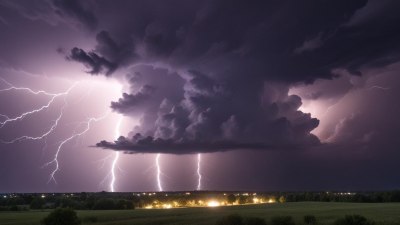How to Stay Safe in a Thunderstorm
Learn essential safety tips to protect yourself during thunderstorms and severe weather.

This image was created with the assistance of Freepik
Thunderstorms are a common weather phenomenon that can occur unexpectedly, bringing with them lightning, heavy rain, and strong winds. Understanding how to stay safe during these storms is crucial for personal safety and preparedness. In this article, we'll explore various strategies and tips to ensure you remain safe when a thunderstorm hits.
Understanding Thunderstorms
A thunderstorm is defined as a rain-bearing cloud that also produces thunder. These storms can develop rapidly and may lead to hazardous conditions like flash floods, tornadoes, and hail. Knowing the signs of an impending storm can help you prepare and take action before the situation becomes dangerous.
Recognizing the Signs
Before a thunderstorm strikes, there are often visible and audible signs that can indicate its approach. Look for darkening skies, increasing wind, and rumbling thunder. The National Weather Service provides guidelines on identifying storm conditions, which include:
- Clouds building up on the horizon.
- Changes in wind direction or intensity.
- Sudden drops in temperature.
- The smell of rain or ozone.
As these signs become evident, it is essential to remain vigilant and prepared for the possibility of a storm.
Preparing for a Thunderstorm
Preparation is key when it comes to thunderstorms. Being informed ahead of time can minimize risks and ensure that you and your loved ones are safe. Here are steps to take before a storm arrives:
- Stay Informed: Monitor weather forecasts from reliable sources like the National Weather Service, local news, or weather apps. Pay attention to storm watches and warnings.
- Create an Emergency Plan: Develop and communicate a family emergency plan that includes how to contact each other, where to meet, and how to evacuate if necessary.
- Prepare an Emergency Kit: Assemble a kit that includes essentials such as water, non-perishable food, a flashlight, a first aid kit, batteries, and any necessary medications.
- Secure Outdoor Items: Bring in or secure any outdoor furniture, decorations, or tools that could become projectiles in high winds.
During the Thunderstorm
When a thunderstorm is occurring, it’s important to take immediate action to protect yourself. Follow these safety tips:
- Stay Indoors: The safest place to be during a thunderstorm is indoors. If you are outside, seek shelter in a sturdy building.
- Avoid Electrical Appliances: Unplug devices and avoid using wired electronics, including phones and computers, as lightning can cause power surges.
- Stay Away from Windows: Keep away from windows and doors to protect yourself from flying debris and shattering glass.
- Don’t Take Shelter Under Trees: While it might seem like a good idea to shelter under a tree, it poses a risk of lightning strikes.
If You Are Caught Outside
If you find yourself caught outside during a thunderstorm, there are specific actions you can take to minimize your risk:
- Seek Shelter: Look for buildings, a car, or low-lying areas to lessen your exposure to lightning.
- Stay Low: If you can’t find shelter, crouch down low with your feet together and your head tucked, minimizing your contact with the ground.
- Avoid Water: Steer clear of lakes, rivers, and pools, as water is a good conductor of electricity and poses additional risks during storms.
- Watch for Flash Floods: If heavy rain falls quickly, stay alert for flash floods. Move to higher ground immediately if you notice rising water levels.
Understanding Lightning Safety
Lightning is one of the deadliest aspects of thunderstorms. According to the National Weather Service, an average of 20 million cloud-to-ground lightning strikes occur in the United States each year. To stay safe from lightning:
- Follow the 30/30 Rule: If you see lightning, count 30 seconds until you hear thunder. If it is less than 30 seconds, seek shelter.
- Wait 30 Minutes: After the last crack of thunder, wait at least 30 minutes before leaving your shelter. This will help ensure that the storm has passed.
After the Thunderstorm
Once the storm has cleared, exercise caution as conditions may still be hazardous:
- Stay Informed: Listen to news reports for updates on residual weather conditions, including possible aftereffects such as flooding.
- Check for Damages: Inspect your property for damages. Look for downed power lines and avoid touching any fallen wires.
- Notify Authorities: If you encounter dangerous conditions, such as downed power lines or flooding, report them to authorities.
Protecting Against Future Storms
Once the immediate storm threat is over, consider reinforcing your home and surroundings for future thunderstorms:
- Install Surge Protectors: Protect your electrical devices from power surges with surge protectors.
- Maintain Trees: Trim branches and remove dead trees that could fall during storms.
- Review Your Emergency Plan: Regularly revisit and update your emergency plan and kit as needed to ensure it remains effective.
Staying safe during a thunderstorm requires vigilance, preparedness, and proper response to storm warnings. By understanding the risks and following the safety measures outlined in this article, you can protect yourself and your loved ones from the dangers of severe weather. Remember that safety should always be the top priority in any storm situation. Stay informed and be proactive in your preparations, and you will be well-equipped to handle thunderstorms effectively.











